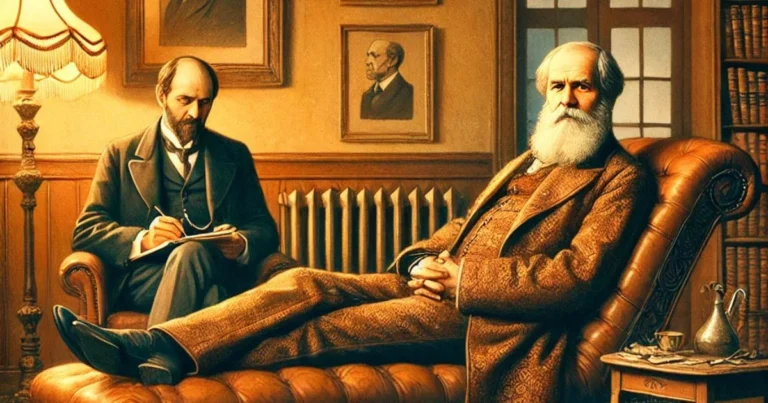Animal magnetism: Mesmer’s intuitive glimpse into the unconscious
We like to believe that our emotions, thoughts, and behaviors stem from rational and observable mechanisms. But what happens when invisible forces, hidden from conscious awareness, prove to be the true architects of our well-being?
In the 18th century, Franz Anton Mesmer, a controversial figure at the intersection of science and mysticism, challenged this assumption by proposing the existence of a universal energy he called “animal magnetism.” A German physician and bold pioneer, Mesmer left an indelible mark on the history of medicine by exploring the mysterious interplay between body and soul. His ideas, both captivating and divisive, paved the way for a radical rethinking of the unseen forces that shape the human condition. This article delves into Mesmer’s extraordinary vision and its influence on medical and psychological practices, tracing its unexpected legacy in modern theories of the mind.
A world on the edge of reason: The 18th century’s hidden beliefs
Mesmer emerged in an age of Enlightenment, a time when science was beginning to establish itself as a rigorous framework for understanding the world. Nevertheless, mystical beliefs and occult practices still permeated European thought. Medicine, in particular, remained tethered to ancient traditions, including the theory of humors and vital energies.
Influenced by Isaac Newton’s theories on gravity and invisible forces, Mesmer formulated his concept of animal magnetism. He believed that, much like gravity, this force operated according to laws that governed the human body. His vision was revolutionary: he argued for a deep interconnection between body, soul, and an invisible force, a concept that marked an early shift in a medical field still undeveloped in its understanding of psychology.
The theory of Animal Magnetism
At the core of Mesmer’s theory was a “universal fluid” he termed animal magnetism. Borrowing from physical magnetism, he believed this invisible force acted specifically upon living beings, the term “animal” deriving from the Latin anima, meaning “soul” or “life.” Much like a magnet influencing objects at a distance, this life force was thought to flow through the body, maintaining harmony between the physical and the mental. Illness, he claimed, resulted from disturbances in this flow.
Mesmer saw himself as a “magnetic conduit,” capable of manipulating this fluid through gestures of the hands to restore its balance. His own body, he believed, functioned like a magnet, redirecting this energy and dissolving the blockages responsible for physical and emotional disorders. He even devised elaborate treatment devices, pools filled with “magnetized” water and metallic rods connecting patients, intended to channel and amplify the effect.
The term “magnetism” lent scientific credibility to his ideas while also reflecting a mystical vision of a universal life force. Mesmer’s approach combined empirical intuition, symbolic ritual, and a nascent recognition of unconscious psychological forces.
Magnetic crises and altered states of consciousness
A particularly intriguing aspect of Mesmer’s sessions was the induction of “magnetic crises”, intense emotional and physical episodes that he interpreted as therapeutic breakthroughs. These crises involved tremors, convulsions, crying, and spontaneous vocal outbursts, all seen as necessary steps in purging the blockages disrupting the flow of animal magnetism.
One of Mesmer’s most notable cases involved Maria Theresia Paradis, a young pianist with functional blindness who reportedly regained partial vision after a series of trance-like sessions accompanied by emotional upheaval. Patients frequently described unusual sensations: numbness, tingling, waves of overwhelming emotion, and resurfacing memories.
Although inexplicable at the time, these phenomena closely resemble modern concepts of hypnosis and altered states of consciousness. One patient recounted being “transported to another reality,” experiencing vivid visions and repressed memories tied to past trauma, described with astonishing clarity.
Mesmer attributed these effects to his magnetic influence. However, they in fact revealed the mind’s hidden depths, dimensions where buried emotions and unconscious material could surface and seek release. While he never formalized a theory of the unconscious, his work foreshadowed Sigmund Freud’s concept of abreaction: the idea that intense emotional expression within a therapeutic context can lead to psychological healing. Mesmer’s techniques, rooted in energy manipulation, inadvertently opened the door to understanding the mind’s unconscious dynamics.
Truth or trickery? The scientific trial of mesmer
Mesmer’s theatrical methods quickly drew criticism from the scientific community. His sessions, complete with magnetized tubs, metallic rods, and ritualistic gestures, blurred the lines between medicine, performance, and charisma. Admirers saw them as cutting-edge healing; skeptics dismissed them as pseudoscientific spectacle.
In 1784, King Louis XVI commissioned a formal investigation by the French Academy of Sciences and the Royal Society of Medicine. The committee included luminaries such as Benjamin Franklin, Antoine Lavoisier, and Joseph-Ignace Guillotin. Their goal was to assess the scientific legitimacy of animal magnetism.
Through a series of controlled experiments, including blind trials where patients were unaware of whether Mesmer was present or whether the “magnetic fluid” had been activated, the commission concluded that the effects were psychological rather than physical. Patients’ responses were influenced more by expectation and suggestion than by any measurable force. While improvements in symptoms were sometimes noted, they were attributed to imagination, not a universal energy.
The report, released the same year, publicly discredited Mesmer, branding him a charlatan. His reputation collapsed in France. Nonetheless, some members of the scientific community recognized that the observable effects hinted at underlying psychological mechanisms still poorly understood at the time.
This episode marks a pivotal moment in the history of science, when rational inquiry began to triumph over mysticism. Still, despite being cast out by Enlightenment rationalists, Mesmer’s legacy endured, laying foundational ideas for future explorations of the mind-body connection.
Before the unconscious had a name
What makes Franz Anton Mesmer particularly compelling is his intuitive grasp of forces that would later be formalized in modern psychology. Through his theory of animal magnetism, Mesmer suggested that physical and emotional ailments could be caused by invisible energetic blockages. Although he never used the term “unconscious,” his practices routinely exposed hidden psychological layers, memories, emotions, and behaviors not governed by the conscious mind.
His work with Maria Theresia Paradis demonstrated that certain altered states could unearth buried traumas and trigger cathartic emotional responses. These observations anticipated the concepts of catharsis and abreaction later developed by Freud and others.
Mesmer also emphasized the role of imagination and patient expectation, principles central to modern understandings of the placebo effect and mind-body interaction. He viewed the soul as a complex energetic field, echoing, albeit metaphorically, later psychoanalytic models of inner conflict.
Although he never codified a comprehensive theory of the unconscious, Mesmer undeniably laid the groundwork for it. He sensed that behind physical symptoms and visible behaviors lay deep, intertwined psychological and somatic processes. In this way, Mesmer served as a transitional figure, bridging mystical interpretations of the self with the birth of scientific psychology.
Where Freud begins, Mesmer whispered first
Separated by a century and vastly different scientific landscapes, Franz Anton Mesmer and Sigmund Freud shared a common ambition: to uncover the hidden forces that govern human behavior. While Mesmer worked with magnetic energies and induced physical crises, Freud later explored unconscious drives and repressed memories through hypnosis and, eventually, talk therapy.
Where Mesmer attributed transformation to an external fluid, Freud redefined these experiences as internal psychic conflicts. He replaced the idea of energy flows with the structured unconscious, the id, ego, and superego. Nonetheless, both men were deeply invested in revealing the mind’s hidden dimensions.
Freud eventually abandoned hypnosis in favor of free association, but the resonance remains. Mesmer’s visionary insights into the power of suggestion, altered states, and emotional release laid a conceptual foundation that psychoanalysis would later rigorously develop.
Gaston Bachelard once wrote, “The history of science is the history of its errors.” This sentiment perfectly captures Mesmer’s role. Although his theory of a universal magnetic fluid lacked empirical support, it inspired a crucial paradigm shift.
His exploration of trance states, suggestibility, and the mind’s influence on the body anticipated many discoveries in modern psychology. Far from disqualifying his contributions, Mesmer’s mistakes provided fertile ground for successors like Jean-Martin Charcot and Sigmund Freud, who built more systematic frameworks upon his early insights.
Ultimately, Mesmer reminds us that even flawed ideas can ignite revolutions in understanding. His legacy endures as a landmark in the ongoing quest to decipher the mysteries of the human psyche.
References
Bachelard, G. (1938). La formation de l’esprit scientifique. Paris : Vrin.
Ellenberger, H. F. (1970). The discovery of the unconscious: The history and evolution of dynamic psychiatry. New York: Basic Books.
Franklin, B., Lavoisier, A., & Guillotin, J.-I. (1784). Rapport des commissaires chargés par le Roi de l’examen du magnétisme animal. Paris : Imprimerie Royale.
Gauld, A. (1992). A history of hypnotism. Cambridge: Cambridge University Press.
Mesmer, F. A. (1779). Mémoire sur la découverte du magnétisme animal. Genève : Slatkine.
Shorter, E. (1997). A history of psychiatry: From the era of the asylum to the age of Prozac. New York: Wiley.
Tinterow, M. M. (1970). Foundations of hypnosis: From Mesmer to Freud. Springfield, IL: Charles C Thomas.

Amine Lahhab
Television Director
Master’s Degree in Directing, École Supérieure de l’Audiovisuel (ESAV), University of Toulouse
Bachelor’s Degree in History, Hassan II University, Casablanca
DEUG in Philosophy, Hassan II University, Casablanca







